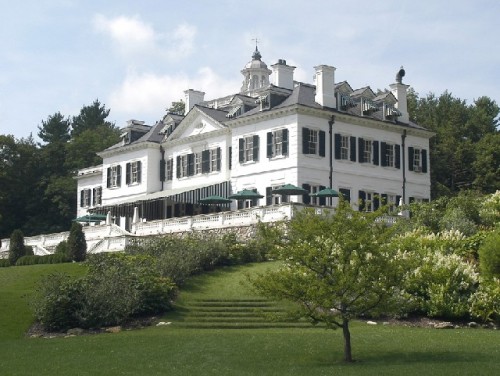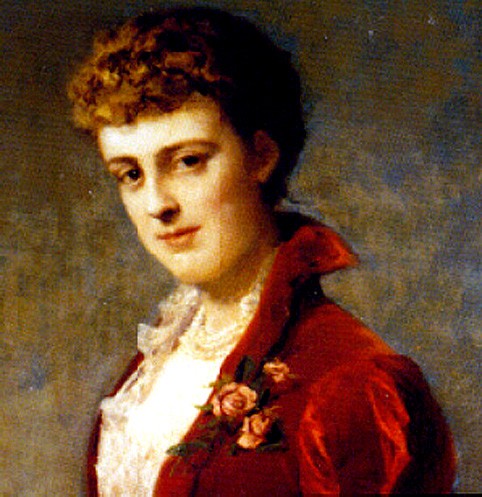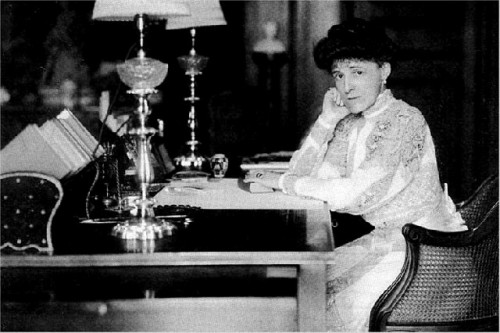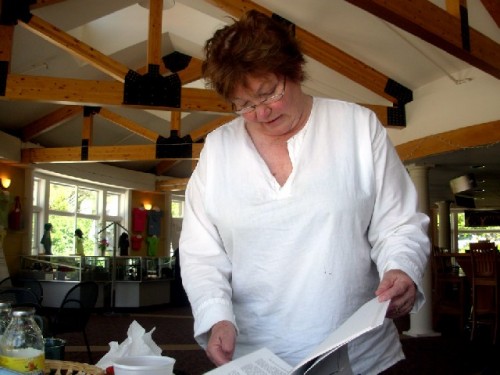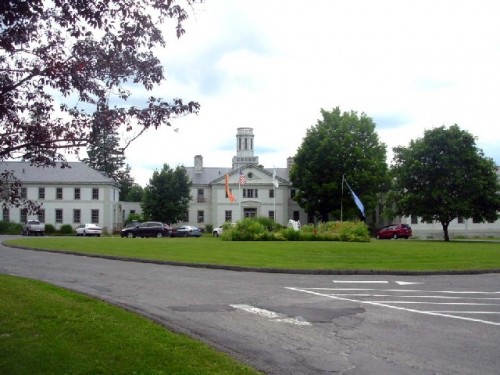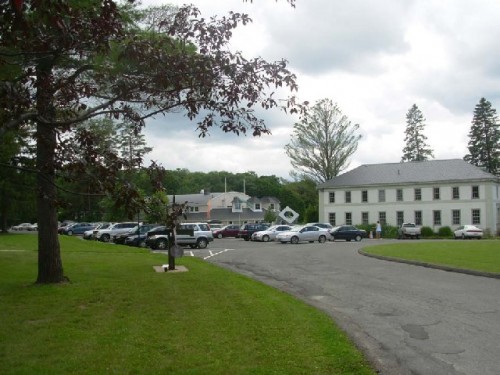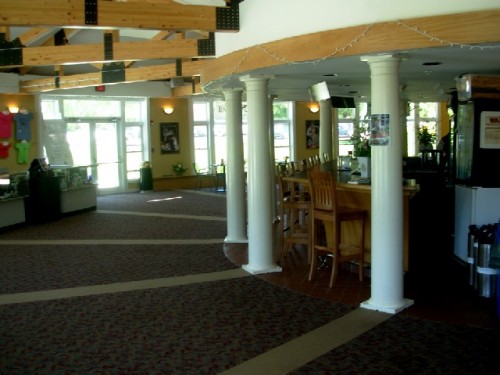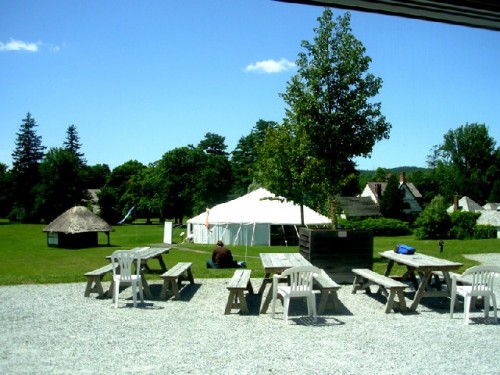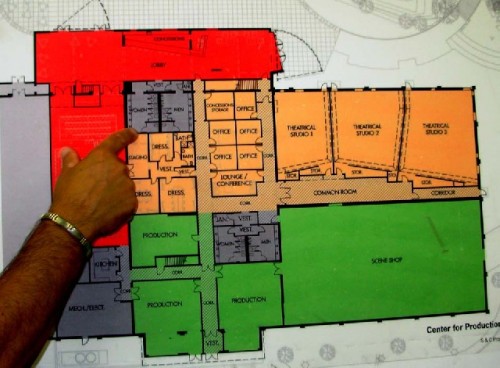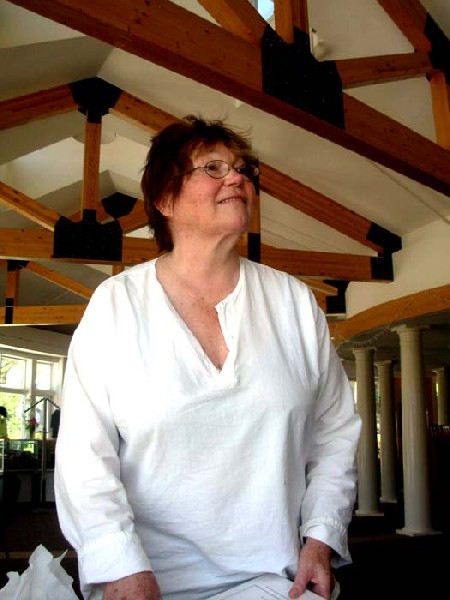Tina Packer: Part Two
Edith Wharton's The Mount and Beyond
By: Charles Giuliano - Aug 25, 2009
In 1977 when Tina Packer and the fledgling Shakespeare & Company moved into Edith Wharton's former estate The Mount there was an abundance of deteriorating real estate in the Berkshires. During the Industrial Revolution the region prospered. There were thriving mills and manufacturing in North Adams, Adams, and Pittsfield in Northern Berkshire County.
With its relative proximity to New York wealthy New Yorkers, the Robber Barons of the Gilded Age, built great estates in Southern Berkshire County in Lenox, Lee, Stockbridge, Great Barrington and Sheffield. The introduction of estate and income taxes between 1906 and 1913, initiated by Theodore Roosevelt, followed by the Stock Market Crash of 1929, led to many of the properties being abandoned.
One such grand estate is The Mount which the author, Edith Wharton (1862-1937) built in Lenox. The mansion and its surrounding formal gardens embodied many of her ideas. It was her residence from 1902-1911. When her marriage ended Wharton lived in France for the remainder of her life. She returned to the United States, in 1923, to receive an Honorary Degree from Yale University.
When Tina Packer, then 39, and the newly formed Shakespeare & Company (S&Co.) were invited to occupy The Mount it was in a state of disrepair. "The Mount was derelict" Tina Packer, the founder of S&Co. recalled some 32 years later. "There were books strewn all over the library of the former school. On the floor we found sheets of ice. The shutters were falling off. Our immediate task was to put the house back into living order. The second thing we did was form Edith Wharton Restoration Inc. (EWR). Mitch Berenson was the president. He had been a battling trade union leader who was fighting the Mafia. In the Elia Kazan film 'On the Waterfront' the Rod Steiger character was based on him."
Initially there were two entities, S&Co. and EWR, with a seemingly common mandate and vision. Packer needed to house her company and initiated a program of performances. Having the property occupied arrested its further deterioration. The notion of its historic preservation came later and resulted in conflict. When I probed into this history she loaned a thick bound volume of which only a few copies exist. It is titled "A Recent History of The Mount and The Relationship between Shakespeare & Company and Edith Wharton Restoration, Inc." It was "Prepared for the Board of Trustees of Shakespeare & Company by Board Members and Staff of Shakespeare & Company, May 15, 1994. Additions and amendments February 23, 1996."
I asked Packer if a book had been published about S&Co. and The Mount? Handing over the 252 page study she replied "You tell me." There is indeed a book project here with rich and colorful material. That is beyond the limits of this report but the documents were useful in finding facts and details to questions that were discussed with Packer during a recent interview.
The conflict would drag on for years with a toll on all of the parties involved. We have heard from the other side through a former EWR board member. While S&Co parted ways, and is now developing its own campus nearby in Lenox, The Mount continues to face financial issues. The latest reports are that it appears to be past threat of foreclosure. This summer it again presented a limited run of a Wharton play, an adaptation of a Wharton story by Packer's husband, the playwright and actor, Dennis Krausnick.
"We loved The Mount" Packer said. "To put on plays in that environment was inspiring. We started reading Wharton and Dennis adapted her stories. We adored The Mount. It was a fertile place to live. Both organizations (S&Co and EWR) were struggling. Eventually the EWR board went on a retreat and consultants told them you have to separate your identity."
In hindsight S&Co might have purchased The Mount and its property for just $300,000. Today that seems like such a small amount of money but Packer commented "It was a lot of money for us. At the time we were operating on an annual budget of $100,000." The 2009 budget is $4.5 million down from $5 million in 2008.
When the EWR board decided to create a separate identity it focused more on meticulous historic restoration. "The last ten years at The Mount" Packer said "Taught me that exact restoration was not the right fit for a theatre company. There were years of arbitration." When the property was sold "S&Co owned it for five hours and then it was transferred (to EWR). Dennis was the Treasurer. You can have the whole bloody history." (The report is quoted from in the Addendum that follows the Packer interview.)
In 2000 Packer and S&Co. bought the Bible Speaks property from The National Music Center for $4.1 million. It had originally been the Lenox School for Boys. In 1987 a court found in favor of Elizabeth Dovydenas in a suit against the group for $6.581 million, which put the Bible Speaks into bankruptcy.
After acquiring the property in bankruptcy court, Jonas and Betsy Dovydenas started the Berkshire Performing Arts Center (BPAC) and ran 3 seasons of an eclectic mix of popular music, jazz, country, blues and comedy acts. Major artists including Wynton Marsalis, Sonny Rollins, Chick Corea, Johnny Cash, B.B. King, Laurie Anderson, Spyro Gyra, Tom Tom Club, Hot Tuna, Meatloaf, Johnny Winter, George Carlin, Seinfeld and others appeared in the ambitious programming. Given the range and ambition of the programming it is unfortunate that there is nothing comparable today in the Berkshires.
At the same time, they hired the architect Andreas Duany to develop the property as a planned neighborhood of mixed housing. That required a change of zoning which the town of Lenox did not approve. The property was then sold to The National Music Center, which failed.
In its planning, The National Music Center secured a grant for $2.2 million for improvements to the water and sewer infrastructure. When the creditors, mortgage and vendors were paid off "The state gave us back a half a million so that brought the purchase price down to $3.6 million" Packer said. The property included 42 acres. The historic mansion Spring Lawn was parceled off with 3 acres for $3.1 million. The structure was designed by Guy Lowell, the architect of the Museum of Fine Arts, Boston and built in 1904 on Kemble Street for John Alexander.
Within a year S&Co raised $5 million for the first phase of renovation which included the Founders Theatre its main stage. At the end of the summer of 2008 the company opened the Elayne P. Bernstein Theatre as a part of the renovation of a former sports complex. The Production and Performing Arts Center (PAPA) represents half of the space of the structure. At the heart of the campus is a complex of historic landmarks designed by McKim, Mead and White. There are long range plan for their renovation. The administrative offices occupy a former library. In an open area behind the main buildings is a round tent in the shape and dimension of Shakespeare's Rose Theatre. Eventually the company would like to build a replica. There are development plans which extend for a generation or more.
In coming to the Lenox campus Packer discussed that most daunting problem was how to use the vast sports complex. "It is what bankrupted all of the former owners" she explained. "It takes so much money to run and maintain. That's why the school went bankrupt. Colonel Wilde, a patron of the school, pledged $1 million to build the sports complex. But when he heard that the boys were protesting against the Vietnam War he withdrew his support. It was built to hold an ice hockey rink and other facilities. There was a huge mortgage and that bankrupted the school." It also proved to be a great drain on the resources of the Bible Speaks, which used it as a chapel and assembly place, as well as a performance space when it was used by BPAC and then the National Music Center to program concerts.
"There was a huge hole in the roof and it cost a fortune to heat" Packer recalled. "We got it under control." The new complex of rehearsal rooms, theatre, scene shop, kitchen, bar and lobby area are designed to function year round. It has been transformed from a liability into an asset. In the current economy, however, there is the challenge of paying down general mortgage and debt with another $2 million left of the $10 million capital campaign. When S&Co. raises an additional $800,000 the Kresge Foundation has offered $1.2 million. As of mid July Packer told me that they had raised an additional $200,000.
Although there are dormitory facilities on campus S&Co also rents five buildings. When abandoned buildings on the campus are renovated, which is a long term goal, those rentals will be eliminated. "Because of teaching and apprentice programs during the summer we house 150 people," Packer said.
There are 40 year round administrators and staff. The company maintains a touring program like "Romeo and Juliet" which this past year was performed for 50,000 people. "We are meant to be a center where people come to" she said.
If you have a state of the art scene shop why does S&Co still mount those bare pipe productions? With some exasperation she exclaimed that "It's a difficult problem and is about money." Right not the new PAPA facility is intended to make money year round like building sets for other organizations, hosting weddings, photo shoots, conferences and meetings. "The idea is that it should earn us money. Also we do all those high school plays."
After some 32 years I asked what assets the company had acquired. "We have 60,000 costumes" she said. "Which we use ourselves as well as rent out. It is culled through every year. Overall our asset base is calculated as $15 million. Right now we have a mortgage of $3.2 million as well as bank debt we are trying to retire."
Having dedicated 32 years to the effort I asked "Why Shakespeare?" She responded with passion as well as insight. "The world needs to understand the role of the arts, Shakespeare, and the function of language. When it was developed in Great Britain where did the art and rhetoric go to? It went into the language of Democracy in the Gettysburg Address of Lincoln, the Declaration of Independence, and the Constitution. It went into the foundation of Democracy in America.
"The way that you use language develops human consciousness. If you don't have language you start to get stupid. It's only through language that we can attack the huge problems of the world. Because you have to think it in order to solve it. Look at the mess that George W Bush left. How many people have died because of careless thinking? We need to train people in the arts and to use language as a means of expressing ourselves. Shakespeare was the favorite author of the founding fathers particularly Adams and Jefferson as well as Nelson Mandela."
In addition to the 50,000 who attending the touring production of "Romeo and Juliet" Packer stated that attendance at S&Co. for 2008 was about 70,000. With 18 productions, a record for the company, it will be interesting to see if there is an increase for the 2009 season. This was Packer's strategy to offset cutbacks. Eventually she sees the potential audience for the Lenox campus in the range of 100,000. Paid admissions, however, do not cover all of the costs of maintenance and development. While Packer has kept the body and soul of S&Co together since its inception in 1977 it will be the challenge for the new Artistic Director, Tony Simotes, to take it to the next level. Indeed, "The play's the thing."
Addendum
Here are just a few higlights from the document that Packer provided. They convey some of the details if not the full flavor of the history of the theatre company and a deteriorating relationship with its host and partner. At first the two entiites S&Co. and EWR worked in harmony but then things fell apart.
In a chronology the following entries: Summer and Fall, 1979 state that "The Company makes two attempts to buy The Mount from Don Altshuler, who at different times contemplates gutting The Mount, building time-share units within 10 yards of the driveway, and selling it to a school for handicapped children. Altshuler turns down a Massachusetts Historic Preservation Commission grant to restore the roof because he doesn't want to be bound by state historic restrictions. The number of liens on the property make purchase difficult."
Entry: Feb 25, 1980 "The option to purchase The Mount is taken by the National Trust, through its Endangered Properties Program. Altshuler agrees to sell the mansion, two gatehouses, 50 acres, plus a right of first refusal on 49 acres, for $300,000. The Board of Trustees of the Foxhollow School, who hold Altshuler's mortgage, agree to forgive $10,000 toward the sale, bringing down the purchase price to $290,000. S&Co. Board and staff members raise $143, 846 toward the purchase."
On May 2, 1980 "The Edith Wharton Restoration, Inc. Board is activated. S&Co. board member, Lila Berle becomes Chairman; Mitchell Berenson remains President, Dennis Krausnick remains as Treasurer and Director of Restoration. Kelton Burbank, S&Co's legal counsel and board member is Clerk; Mitch Berenson, Maria Cole, and Tina Packer also serve as EWR/ S&Co cross-over board membersÂ…"
July 1, 1980 "The National Trust purchases the property and immediately resells it to EWR. S&Co transfers $133, 846 which pays the National Trust $100,000 and uses $33, 846 for immediate restoration necessities. EWR has three years to raise the remaining $190,000. An agreement is signed between the National Trust and EWR to loan the money at 6% over 30 years with monthly payments and one balloon payment of $182, 784.77 to be paid on July1, 1983. The new deeds of the property state that the property should be used for 'theatrical and educational purposes.' The deed prohibits the building of any new structures on the property but allows for the already existing non-historical structures such as the Mainstage, the light stanchions, a concessions stand, and the Wharton Theatre lights and seating."
1984-1990 "The relationship between the two organizations fluctuates. Included in the disagreements are issues about: *which organization should be in charge of maintenance of the property *how much space S&Co should yield to EWR *who should pay how much for water, electricity, heating, sewage disposal and septic pumping *how the Edith Wharton plays should be produced *who owes how much to whom *how house tours and performance schedule should co-exist *whether rental of The Mount by EWR for private weddings is an illegal commercial use of the propety"

